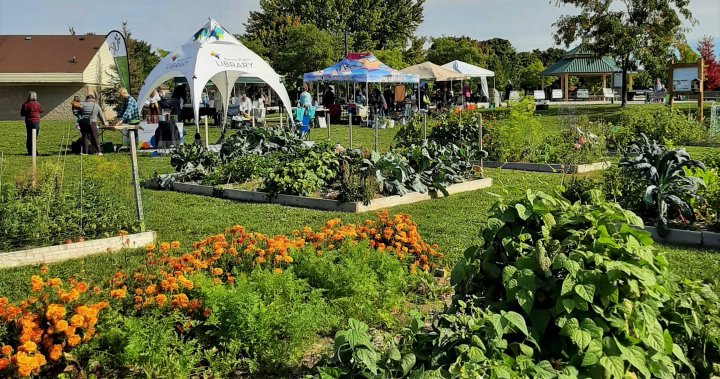General News
Growing your own food. Experts in Ontario weigh in on if it saves you money

With food prices continuing to sore, more Canadians find it harder to afford basic necessities, meaning fresh produce is often left off the grocery list.
Global News turned to some Barrie, Ont., organizations to see if starting a garden was a viable solution to help combat the impacts of inflation.
Read more:
Food prices have fallen on world markets. Why not on kitchen tables?
A report from Statistics Canada released last year found that since the start of the pandemic, interest in gardening has grown drastically, with the total sales in the gardening sector up 7.5 per cent to $4.7 billion in 2021. Ontario made up more than 55 per cent of all sales.
Sales for greenhouse fruits and vegetable plants rose 9.3 per cent in 2021, primarily in produce like tomatoes and peppers.
Are home gardens a viable option?
“I think that there is a growing interest in gardening in general, and I think one of those reasons is in an effort to reduce the costs at the checkout and the grocery (store),” said Deanna De Forest, a board member with Living Green Barrie.
Living Green Barrie is a charitable organization involved in several green initiatives in the community, as well as helping people learn about living more sustainable lives.
De Forest said there are several ways people can start their own gardens, for little cost, to help combat the cost of food.
“I think beginning at home gardening can be easy, and it doesn’t have to be expensive, mostly because it can be scaled to the amount of space, time, the resources it has available,” she said.

How to get started
De Forest said while there are some upfront costs, people can find ways to make it affordable, like up-cycling containers, being conscious of the time of day they water, and setting up a rain barrel system to avoid increasing their water bill.
“If you’re looking at combating all the rising costs of food, you might want to consider growing fresh produce that you eat the most of at home, or maybe that’s the most expensive to buy in the grocery store,” she said.
Read more:
Inflation seems to be cooling — except at the grocery store. What’s going on?
De Forest recommends that people focus on growing crops that store well or that give a high yield, like tomatoes and salad greens.
She also pointed to resources like the Barrie Public Library’s seed library or garden tool kits.
For those without a lot of space, De Forest said people could either do smaller pots on a balcony or even rent a community garden plot.
The average price for community garden plots ranges from around $20 to $50 a year.
Data from Statistics Canada released in February shows food prices continue to rise – up 10.4 per cent year-over-year in January – up slightly from December.
Since late 2021, the agency said price increases for food sold in stores, measured year-over-year, have outpaced headline consumer inflation, growing faster than 10 per cent in August, September and October 2022.
Many food categories saw prices accelerate from December.
Other affordable options for fresh produce
Jenna Zardo with the Canadian Mental Health Association (CMHA), Simcoe County, is the coordinator of the Urban Pantry, which offers cooking classes, provides fresh produce boxes and runs 11 community gardens throughout Barrie.
Zardo said while community gardening and starting your own garden is not a primary solution to food security, it can be a tool in helping combat it.
Zardo says the community gardens they have set up with the help of other community partners have enabled people to grow enough produce for themselves with enough left over to donate. Some community groups specifically grow food to donate to organizations in need.
“We’re actually seeing that the gardeners are growing so much that they’re leaving food out just for the neighbours to take,” she said.
She notes people can also look for local gardening groups online where people share gardening knowledge and excess produce.
In addition to running community gardens, Zardo says Urban Pantry is helping the community through the Good Food Box.
Urban Pantry Good Food Box. Barrie Ontario.
Supplied by Canadian Mental Health Association Simcoe County Branch
Through the Barrie Good Food Box program, Urban Pantry purchases locally-grown produce at wholesale prices and then passes the savings on to consumers.
Zardo says the box of fresh produce costs $20, compared to buying the same produce at the grocery store for between $35 to $50.
Addressing food insecurity is not a one-size-fits-all solution, however. Zardo says while starting a small garden or getting involved in a community plot can help, the government must make policy changes.
“We are seeing an increase in people seeking out our services. We get calls from folks who don’t have any food for their children, they may have already accessed the food bank, or maybe they can’t get down to the food bank if they don’t have reliable transportation,” Zardo said.
Anyone looking to access resources Like the Barre Good Food Box or community gardens can go to Urban Pantry Barrie website.

– with files from Global News’ Craig Lord
© 2023 Global News, a division of Corus Entertainment Inc.
Disclaimer: No copyright infringement intended. All rights and credits reserved to respective owner(s).

























